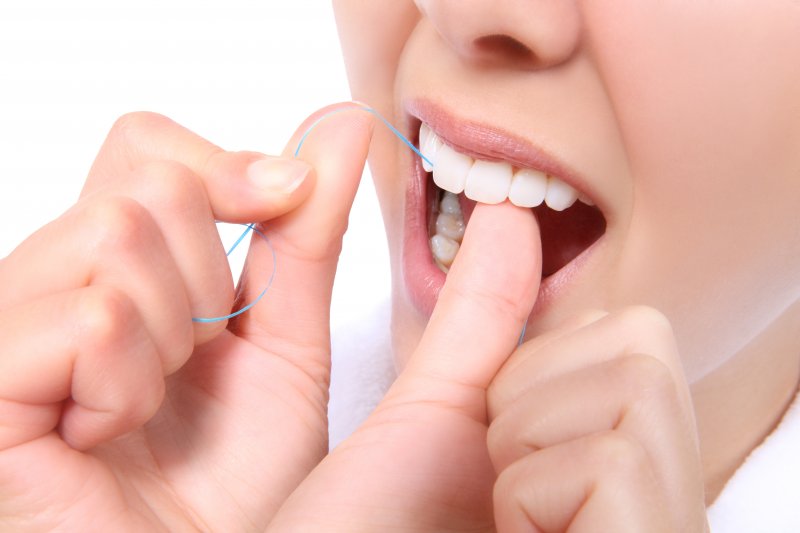Your Dentist Offers Tips on How to Flawlessly Floss
March 31, 2019

Sometimes you may cut corners in your dental routine by not flossing. You figure it’s not going to affect you much because you still brush. But every time you see your dentist for your semi-annual checkup and cleaning, they notice and tell you that it is essential to do this step. But why? In reality, adding a couple of extra minutes to your oral hygiene routine to floss can be the one thing that keeps you from developing bad breath, or worse, gum disease. Your dentist can help you achieve a flawless floss with the following steps and tips.
(more…)DENTISTRY IN THE NEWS – PART 1
March 25, 2019
A recent U.S. News & World Report featured seven pages of information on dentistry. Although I was surprised that most of the information was accurate, as the media often skews the facts to make a point, there were a few things that I felt needed clarification.
The first article highlights the fact that 75% of adults have some form of periodontal disease. This is true. It also mentions many of the known facts with regards to gum disease and systemic health. One of those is that uncorrected gum problems can make it more difficult for diabetics to control their blood sugar, and in turn worsen their gum problems. This is also true.
With regards to brushing, the article states, “Scrubbing with fluoride toothpaste robs oral bacteria of sustenance.” This is true to some extent but the term “scrubbing” is not completely accurate. Proper brushing technique with either a very soft manual toothbrush or good electric toothbrush is a more accurate description. Also, fluoride, in and of itself, is not truly anti-bacterial. Although it is felt that its anti-cavity action is related mainly to effects on mineral phases of teeth and on the process of remineralization (strengthening enamel), research does show that fluoride also has important effects on the metabolism of bacteria in dental plaque. There are other ingredients in toothpastes with and without fluoride that are more anti-bacterial, but it is the removal of plaque manually that is most important, even without toothpaste.
With regard to electric toothbrushes, the article insinuates that “basic” and “cheap” ($7) models are as effective as more expensive models. This is false. Although you do not have to buy the most expensive model available, there is a huge difference in effectiveness between a $7 battery-operated toothbrush and a $70 wall-charged one.
The article states, “Only floss can reach below the gum-line.” This is not completely true. Proper toothbrush technique gets below the gum-line on two sides of the teeth. Floss is important for removing debris between teeth. A water pik is probably most effective for cleaning the non-brushable areas in the mouth.
For combating bad breath, the article’s first suggestion is to “brush your tongue.” Although it mentions the use of a tongue scraper, it only states the use of this device if your toothbrush makes you gag. The fact of the matter is that a tongue scraper is 100% more effective in removal of the nasty bacteria on your tongue. If the toothbrush makes you gag so will the tongue scraper. One trick is to scrape your tongue while you are exhaling.
An article in the report entitled, “21st-Century Dentistry” highlights the use of lasers in treating gum problems. The beginning of the column gets you revved-up to believe that this is the best thing since sliced bread, but the end of the article states differently. “It is unlikely to fully replace traditional gum surgery anytime soon. The laser therapy isn’t demonstrably superior to surgery, researchers recently reported in the Journal of Periodontology.”
To be continued…….
Dr. St. Clair maintains a private dental practice in Rowley and Newburyport dedicated to health-centered family dentistry. If there are certain topics you would like to see written about or questions you have please email them to him at jpstclair@stclairdmd.com. You can view all previously written columns at www.jpeterstclairdentistry.com/blog.
UNDERSTAND THE “WHY”
March 19, 2019
Change is inevitable. While there are some changes that take place we have little control over, there are other changes that we have to initiate to move forward.
Changing our behavior, habits, attitude, or any aspect of our lives can be a challenge. I am not writing as an expert on this subject as I have the same struggles as everyone else with change. However, repeated awareness of changes we want to make is one strategy to move us closer to making that change; for example, your dental hygienist reminding you to floss. Effective?
Mary, a patient of mine, is an adult who has had issues with decay (bacterial disease that breaks down tooth structure), dental erosion (chemical breakdown of tooth structure), and gum recession (loss of the supporting structures of the teeth). When people like Mary present with these problems, we dentists like to present treatment to “fix” the problems. However, the reasons “WHY” these issues are occurring are just as important, if not more so, than the “fixes” we propose. We have to understand the “why” in order to focus on changing the causes.
Mary drinks diet soda. In fact, Mary doesn’t just drink diet soda; she has a diet soda by her side all day long. At a recent event I saw Mary sitting and listening intently to the presentation. At her side was her diet soda. Every few minutes Mary would unscrew the diet soda cap and take a swig.
The three main dental issues Mary has, decay, erosion, and recession, have many different etiologies. One common denominator is pH, which is a scale used to describe the acidity or alkalinity of solutions or environments. The lower the pH, the more acidic the solution or environment is. In order for any of the three disease processes described above to occur, the pH of the oral environment has to be acidic.
While there are many reasons the pH of the oral environment can be acidic, such as medications or disease, dietary factors play a significant role. A pH lower than 5.5 in the oral cavity puts you at risk for dental disease. Most tap water, for example, has a pH of 7. The average diet soda has a pH of 3.28. Stomach acid has a pH between 1-2. Diet soda is very acidic.
Having a diet soda with a meal on occasion is most likely not a problem. Typically, after consumption of an acidic beverage, your saliva will neutralize (make your mouth more alkaline and less acidic) within about a half hour. That is why you may have heard that you should wait at least a half hour before brushing your teeth after meals. The problem with Mary sipping the diet coke all day long is that the pH of her mouth is always acidic. This creates a very dangerous environment.
Quieter drills, new materials and technologies will not solve these problems. While etiologies such as medications that can cause dry mouth and a very acidic environment are difficult enough to manage, behavioral issues are often not discussed in enough detail, or at all because they can be more difficult to manage. However, this is the key area for the dental provider to help the patient understand and initiate change.
Avoidable dental problems are the last thing a patient wants to hear about and a dentist wants to see. The next time your dentist or dental hygienist tells you there is a problem, such as a new cavity, bleeding gums, or worn/broken teeth, ask them to explain why this is occurring. Hopefully, this will lead to the start of changes to help this from happening again.
Dr. St. Clair maintains a private dental practice in Rowley and Newburyport dedicated to health-centered family dentistry. If there are certain topics you would like to see written about or questions you have please email them to him at jpstclair@stclairdmd.com. You can view all previously written columns at www.jpeterstclairdentistry.com/blog.
IS ONCE ENOUGH?
March 11, 2019
Despite the generalized notion that people should visit a dentist bi-annually, I am more a proponent of individualized frequency recommendations based on a few factors. We are not all the same; therefore each of us has our own specific needs.

Results from a recent Gallup-Healthways poll of 355,334 Americans indicate that more than one-third of the population, 34% to be exact, did not visit a dentist last year at all. Over 50% of the population said they visited the dentist one time or less last year.
In a study reported in The New York Times and other major media, a report by the Journal of Dental Research indicates “little evidence supports biannual preventive care for all adults.” Similarly, the headline from HealthDay News read, “Annual Dental Cleaning May be Enough for Some.”
The researchers explored the association between long-term tooth loss and the frequency of preventive dental visits in adults with and without three risk factors for periodontal disease: smoking, diabetes and interleukin-1 genetic variations (regulates immune and inflammatory responses). Subjects were deemed low risk if they had none of these factors.
The data showed that as a group the high-risk patients who had two preventive dental visits lost significantly fewer teeth compared to the high-risk group that had only one preventive dental visit per year. By contrast, there was no difference in tooth loss for the groups at low-risk based on one versus two preventive visits per year. The researchers concluded that individual risk factors should dictate the frequency of cleanings.
The American Dental Association recommends regular dental visits at an interval determined by the patient’s dentist. The patient’s dentist makes an individualized recommendation based on the patient’s health history and current oral health status.
Here are some points that may help you understand the study and the importance of personalized care:
• The key takeaway from this study is that personalized oral care—taking into account your oral and overall health history—is necessary for good dental health.
• The study only looked at tooth extraction and its association with risk factors for gum disease; however, other health conditions can contribute to poor oral health, so that’s why personalized dental care is critical to good patient care.
• Personalized treatment plans should be the priority. Recommendations for future dental appointments should be based on what is seen during your examination, your health history, and any concerns you may have about your oral health.
• The American Dental Association’s website at www.mouthhealthy.org has a lot of information on how to take care of your oral health between dental visits.
While there is clearly a segment of the population who can “get away” with visiting a dentist once a year to maintain a healthy mouth, this group is relatively small. 75% of the population has some form of gum disease. Within that group, there are those who should see a dentist/hygienist twice per year, some three times and others four times or more to maintain proper health.
It is up to you and your dentist to have an open conversation about how often you should go. If it has been a while, getting there the first time is step number one.
Dr. St. Clair maintains a private dental practice in Rowley and Newburyport dedicated to health-centered family dentistry. If there are certain topics you would like to see written about or questions you have please email them to him at jpstclair@stclairdmd.com. You can view all previously written columns at www.jpeterstclairdentistry.com/blog.









